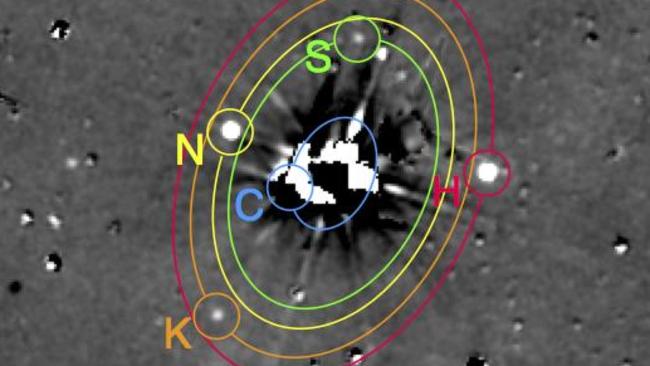As a Pluto probe begins its final approach, Hubble finds its moons tangled in chaotic orbits
THINGS tend to get a little weird out on the fringes. It’s certainly so with Pluto: It can’t seem to control its wayward moons.

THINGS tend to get a little weird out on the fringes. It’s certainly so with Pluto: It can’t seem to control its wayward moons.
Like a harried parent, Pluto’s five “children” appear to be leaping about all over the place.
Hubble Space Telescope images of Pluto, its largest moon Charon, and tinier moons Styx, Nix, Hydra and Kerberos show the odd rhythmical gyrations of the six distant objects in a dance unlike anything in the system.
It’s a chaotic rabble with implications: The New Horizons’ probe is set to skim 12,500km above the outer world at incredible speeds — well within the orbits of the bratty satellites.
It will be the first close encounter with a new planet since Voyager 2 passed by Neptune in 1989.
So far, its path seems clear.
First hazard search data is in and analyzed from New Horizons: The Coast Is Clear--So Far. http://t.co/cPDpmZCS5d pic.twitter.com/ctu3YtVKPm
— NewHorizons2015 (@NewHorizons2015) May 28, 2015What makes things so odd is that there’s a double set of dances going on.
First, Pluto and Charon are locked together in their own waltz “as if they are a dumbbell” with a rod connecting them, said study author Mark Showalter of the SETI Institute in California.
It’s the solar system’s only binary planet system, even though Charon isn’t technically a planet, he said. Pluto, too, is no longer considered a full planet.
“It’s pretty darn weird,” Showalter said.
#Hubble Finds Two Chaotically Tumbling Pluto Moons http://t.co/jT8Tfw1u8g pic.twitter.com/f0J9Cei8tw
— HubbleTelescope (@HubbleTelescope) June 3, 2015But Pluto and Charon aren’t alone, and that’s where it gets more complicated.
The four little moons circle the Pluto-Charon combo, wobbling a bit when they go closer to either Pluto or Charon, being pushed and pulled by the two bigger objects.
Those four moons orbit Pluto-Charon in a precise rhythmical way, but with a twist: They also interact when they near each other. So it seems like they all dance to one overarching beat but not quite in the same way, just doing their own thing, said planetary scientist Heidi Hammel of the Association of Universities for Research in Astronomy.

“It’s kind of like you’d see at a Grateful Dead concert,” Hammel said. She wasn’t part of the study, but praised it as giving a glimpse of what might be happening in other distant star systems where there are two stars and planets that revolve around them, like the mythical Star Wars world of Tatooine.
Nice depiction of Earth and Pluto to scale. Big planets and small. pic.twitter.com/Ijs9WaAKKm
— NewHorizons2015 (@NewHorizons2015) May 28, 2015With the tiny moons wobbling and flipping over in an unpredictable and chaotic way, if you lived on Nix or Hydra, the sun would come up in different parts of the sky, if at all on some days, Showalter said.
“It’s a very strange world,” he said. “You would literally not know if the sun is coming up tomorrow.”
NASA’s $700 million New Horizons spacecraft will arrive in the Pluto system in mid-July after a nine-year 5 billion kilometre flight that started before Pluto was demoted to dwarf-planet status.
We are just six weeks away from the Pluto encounter! pic.twitter.com/Z95JVj9Apt
— Alex Parker (@Alex_Parker) June 2, 2015


